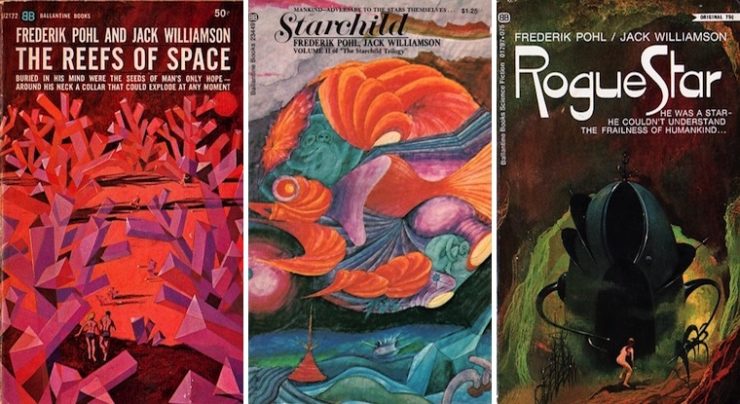In this bi-weekly series reviewing classic science fiction and fantasy books, Alan Brown looks at the front lines and frontiers of the field; books about soldiers and spacers, scientists and engineers, explorers and adventurers. Stories full of what Shakespeare used to refer to as “alarums and excursions”: battles, chases, clashes, and the stuff of excitement.
Today we’re going to revisit a trilogy by two authors, Frederik Pohl and Jack Williamson, who each had science fiction writing careers spanning more than seven decades. The first book, The Reefs of Space, is one of the first science fiction books I ever read, and every time anyone talks about the Oort Cloud, the Kuiper Belt, or indeed any trans-Neptunian object (TNO), those eponymous reefs are the first things that come to my mind. So, lets see how that book holds up upon re-reading after fifty years (pretty well, actually), and we’ll also look at two sequels that just recently came to my attention which don’t quite live up to the original (well, one out of three ain’t bad). Which raises the question—what does a reader do when bad books happen with good authors?
A fun part of preparing this column is going to used bookstores to search for books I enjoyed in my youth, but which have not become part of my book collection over the years. The musty odor of aging books and the thrill of the hunt has a primal allure. I found this collection in my local comic shop, Fantasy Zone Comics and Used Books. I had been looking for something by Frederik Pohl, and was excited to see the volume included the 1963 novel The Reefs of Space, one of the first grown-up science fiction novels I ever read, and a book I remembered fondly. I was even more excited to find that The Reefs of Spacewas the first book in a trilogy. The book had an open ending hinting at further adventures, and I was interested to see what happened next.
When I was young, what first attracted me to The Reefs of Space was the paperback’s cover, which showed a man and a woman in bathing suits running across a mysterious red plain covered with giant crystals. “If those reefs are in space, why aren’t they wearing space suits?” I wondered. The book had a profound effect on me because it was so different from other stories I had encountered, up to that point. It was definitely not a sanitized tale targeted toward younger audiences. At the same time, it was not like the “grownup” stories I had been reading so far, largely from the pages of Analog, which appealed mostly to the intellect. The Reefs of Space, while it contained lots of science, was a work that targeted the emotions, and employed metaphor and imagery to great effect. It was not a tale that would have been selected by John Campbell, which made it something new and different for me (I later discovered that The Reefs of Spacefirst appeared in If magazine, which would eventually merge with Galaxy Science Fiction in the mid-‘70s).
It was a fun trip down memory lane to revisit The Reefs of Space. Unfortunately, those two sequels were a trip down a lane I wish I had avoided.
About the Authors
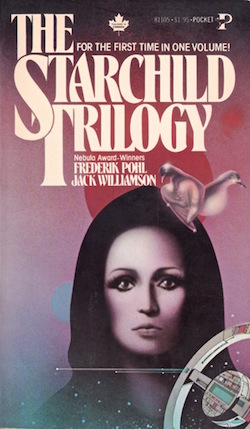 Frederik Pohl (1919-2013) was not only a science fiction writer, but also a magazine, book and anthology editor, an agent, a pioneer of organized fandom, and a president of the Science Fiction Writers of America. He was a member of the Futurians fan group along with other future luminaries who included Isaac Asimov, Damon Knight, and Judith Merril. As a literary agent, he represented many of the biggest authors in the field.
Frederik Pohl (1919-2013) was not only a science fiction writer, but also a magazine, book and anthology editor, an agent, a pioneer of organized fandom, and a president of the Science Fiction Writers of America. He was a member of the Futurians fan group along with other future luminaries who included Isaac Asimov, Damon Knight, and Judith Merril. As a literary agent, he represented many of the biggest authors in the field.
Pohl’s writing career spanned more than 70 years. He frequently wrote with co-authors, with his two most frequent collaborators being C. M. Kornbluth and Jack Williamson. In the 1970s, when he began to put aside his other roles, he wrote what many see as his finest solo works, including the multi-award-winning Gatewayand the Heechee series, and books like Man Plus.
Pohl was an influential magazine editor. He worked as an editor and assistant editor for a number of magazines before becoming the editor of both Galaxyand Ifduring the 1960s, with the latter magazine winning three Hugo awards under his leadership.
He garnered many awards during his career, receiving Hugos for editing, fan writing, and fiction (including the novel award for Gateway), two Nebula awards, and two John W. Campbell Memorial awards. He was selected for the SFWA Grand Master Award in 1993 and inducted into the Science Fiction Hall of Fame in 1998. A number of works by Pohl can be found on Project Gutenberg.
Jack Williamson (1908-2006), was among the most flexible and durable of science fiction writers, with the publication of his first story in 1928 beginning a career that would span more than seven decades. Magazines in which his work appeared include Amazing Stories, Wonder Stories, Weird Tales, Astounding/Analog Science Fiction, Startling Stories, and Marvel Science Stories.
He was a major voice in science fiction’s early pulp days, with his Legion of Space series a prime example of the sprawling and lurid space operas of the era. He also wrote the Legion of Time series, chronicling a war that involved time travel and alternate worlds. Williamson’s other works included the Seetee series and the Humanoids tales.
Putting aside pulp adventures to adapt to changing markets, he reinvented himself as an Astoundingwriter, and was a frequent contributor during the magazine’s Golden Age. One of his stories from this period coined the word ‘terraforming.’
In the 1950s and 1960s, Williamson developed a writer’s block, and was less prolific. Most of his works from this period were collaborations such as the Starchild Trilogy.
Williamson was involved in academic pursuits throughout his career, and from 1960 to 1977 taught English literature as a college professor. After his retirement from academia, he rededicated himself to writing fiction, and was productive during the remainder of his lifetime.
His career was recognized by the SFWA Grand Master Award, the World Fantasy Award, and induction in the Science Fiction Hall of Fame. A number of works by Williamson can also be found on Project Gutenberg.
The Reefs of Space
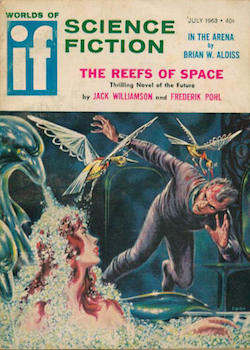 One thing apparent from the start is that this book wears its heart on its sleeve, making no attempt to be subtle. We meet Steve Ryland, a “Risk” marked as a possible threat to The Plan of Man as he is being transferred from a labor camp. He is locked into an iron collar packed with explosives, and his guards wear demonic-looking radar horns that can trigger those explosives. Everyone in the society uses ubiquitous (and to a modern reader, anachronistic) teletype machines to report their every move to the Machine, the supposedly infallible computer that guides every detail of the Plan’s implementation. Steve has amnesia as a result of being tortured for information, and while his captors hound him with words like ‘spaceling,’ ‘reefs of space,’ and ‘jetless drive,’ he has no idea why these terms are important. He only knows that he had an interest in space travel, and owned banned books on the subject. He is being moved by a ‘subtrain’ traveling in an airless tube bored straight between points on the Earth’s surface, with only insubstantial force shields protecting the tunnel from the magma of the planet’s core. Those trains fascinated my young imagination, and are one of the elements from the book I remembered for decades afterward.
One thing apparent from the start is that this book wears its heart on its sleeve, making no attempt to be subtle. We meet Steve Ryland, a “Risk” marked as a possible threat to The Plan of Man as he is being transferred from a labor camp. He is locked into an iron collar packed with explosives, and his guards wear demonic-looking radar horns that can trigger those explosives. Everyone in the society uses ubiquitous (and to a modern reader, anachronistic) teletype machines to report their every move to the Machine, the supposedly infallible computer that guides every detail of the Plan’s implementation. Steve has amnesia as a result of being tortured for information, and while his captors hound him with words like ‘spaceling,’ ‘reefs of space,’ and ‘jetless drive,’ he has no idea why these terms are important. He only knows that he had an interest in space travel, and owned banned books on the subject. He is being moved by a ‘subtrain’ traveling in an airless tube bored straight between points on the Earth’s surface, with only insubstantial force shields protecting the tunnel from the magma of the planet’s core. Those trains fascinated my young imagination, and are one of the elements from the book I remembered for decades afterward.
Steve is escorted to the private subtrain car of the Planner, Earth’s despotic ruler, and one the way stumbles upon the private chambers of the Planner’s daughter, Donna Creery. Because the subtrain’s acceleration bothers her, she is lounging in her bubble bath. At this point, I began to think that these are the most inept fascists ever, letting a convict wander in on a dignitary, but actually, this is a clue that Steve is something more than he seems. And even during my first reading, I realized there is a lot of sexual innuendo in this book. As is the case with many books of the time, the sex is offstage, nestled between paragraphs and chapters, but it is there. Donna is protected by some vicious and ironically named robotic ‘peace doves.’ After she questions Steve, he is led in to see the Planner, who already knows Steve and wants him to work on a jetless drive.
Steve is shipped off to the Team Center, where servant/cheerleaders called Togetherness Girls take care of his every wish (and again, while sex is not mentioned, it is certainly implied—whoever came up with the Plan of Man had narrow ideas about a woman’s role in society). Steve meets the project’s military leaders, learns of a human mission to the reefs of space, and is shown the spaceling: a mammal from the reefs which propels itself with a jetless drive and creates a bubble of atmosphere around itself. The spaceling is described like a seal, with limpid eyes and fur, and we are obviously intended to sympathize with it.
To the chagrin of the military men, the Machine puts Steve in charge of the research project. Steve is surprised when Donna Creery lands a rocket at the facility, and shows a personal interest in the spaceling. But Steve cannot uncover the secrets of the spaceling, and the military men, who intend to torture the secrets out of the poor creature, are put back in charge.
Buy the Book
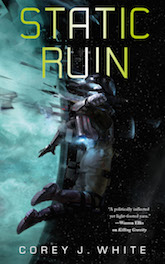

Static Ruin
Because of his failure, Steve is sent to the Body Bank, where donors live in a prison resembling a tropical country club, serving the Plan by donating their organs and body parts piece by piece to others. Organ transplants were becoming viable in the 1960s, and this section is an early, and dystopian, speculation on where that medical capability might lead. In my youth, I found this part of the novel horrifying, and it became the subject of more than one nightmare. Steve also encounters the former girlfriend that betrayed him, who has donated both arms and both legs, and is confined to a motorized wheelchair, but who still professes loyalty to the Plan; a rather creepy part of the story. Steve discovers he is not bothered at the thought of donating his organs, realizes he is being drugged, and tries to find ways to escape while surviving on rain water and whatever sustenance he can glean, becoming weaker in the process.
To avoid spoilers, I won’t tell you how Steve escapes, but it takes little guessing to know that will happen. And as you would expect, Steve and Donna end up traveling to the reefs of space, and exploring its many mysteries. The idea of the reefs comes from 20thCentury astronomer Fred Hoyle’s theory of a steady state universe, which involved new hydrogen being created between the stars to replace the matter being converted to energy within the stars themselves. While Hoyle’s theory has largely been abandoned, the imagery still works well, with the creation and growth represented by the reefs providing a stark thematic contrast with the stagnant tyranny of the Plan. The ecology of the reefs is built around tiny fusorians, creatures that take all the upwelling hydrogen and turn it into energy, and support a variety of higher animals which include spacelings and also pyropods, a kind of living rocket. The exploration of the reefs was one of my favorite parts of the book.
But Steve and his allies are pursued by the military forces of the Plan, and there is a clash in which the fate of the human race, and its only chance for freedom, hang in the balance. The book, filled with vivid imagery from the start, remains true to its theme of oppression versus freedom right up to its action-packed end. The tale has its flaws, but its passion, vivid imagery, and headlong rush of narrative made for a compelling re-read.
Starchild
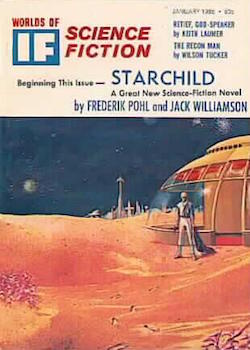 This book, written a year after The Reefs of Space, starts with a showstopping moment during which the Sun and nearby stars are momentarily extinguished, and when they come back to life, the authorities are delivered a “Writ of Liberation” from an entity calling itself the “Starchild.” Surprisingly, given the promise of change at the end of the previous book, the reader finds The Plan of Man and its Machine are still firmly in control of the Earth. We are introduced to Boysie Gann, a promising young major who had been sent to spy on potential traitors, leaving behind his girlfriend Julie. He discovers a plot, only to be kidnapped to the reefs himself. There, he is helped by a man who turns out to be a kind of ghost and meets a pretty girl named Quarla. When he encounters a madman ranting about the Starchild and the Church of the Star, he finds himself instantaneously transported back to Earth. Boysie is interrogated by Sister Delta Four, who has been implanted with circuitry, making her an impersonal sub-unit of the Machine. And to his horror, in one of those coincidences that can shatter a reader’s suspension of disbelief, the Sister is his old girlfriend Julie.
This book, written a year after The Reefs of Space, starts with a showstopping moment during which the Sun and nearby stars are momentarily extinguished, and when they come back to life, the authorities are delivered a “Writ of Liberation” from an entity calling itself the “Starchild.” Surprisingly, given the promise of change at the end of the previous book, the reader finds The Plan of Man and its Machine are still firmly in control of the Earth. We are introduced to Boysie Gann, a promising young major who had been sent to spy on potential traitors, leaving behind his girlfriend Julie. He discovers a plot, only to be kidnapped to the reefs himself. There, he is helped by a man who turns out to be a kind of ghost and meets a pretty girl named Quarla. When he encounters a madman ranting about the Starchild and the Church of the Star, he finds himself instantaneously transported back to Earth. Boysie is interrogated by Sister Delta Four, who has been implanted with circuitry, making her an impersonal sub-unit of the Machine. And to his horror, in one of those coincidences that can shatter a reader’s suspension of disbelief, the Sister is his old girlfriend Julie.
We finally get some backstory explaining what happened to Steve and Donna from the last book, which to me was pretty disappointing. And the book begins to get muddled. Boysie ends up being implanted with circuitry like Julie, and programmed to serve the Machine, and the two of them end up battling power-hungry officers who want to take over The Plan of Man. When it turns out that people in the reefs are being turned into tools of the Church of the Star, suddenly the book is no longer about freedom versus tyranny. We do find out who the Starchild is, but I didn’t find the answer too satisfying. Overall, those parts of the novel that echoed themes in The Reefs of Spacewere not too bad, but those that brought in new ideas and material fell flat.
Rogue Star
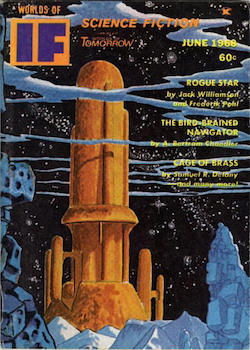 This book was written four years after Starchild, and in my opinion, shouldn’t have been written at all. The story is built around a romantic triangle consisting of Andreas Quamodian, the girl he loves, Molly Zaldivar, and the man she loves, Cliff Hawk. The nebbishy Andreas is a Monitor in the Companions of the Star, a kind of interstellar administrator. Most of humanity has joined in symbiosis with the Starchurch, becoming one with alien races and intelligent stars (yes, you read that right). Molly has followed Cliff to Earth, where he is in an abandoned facility of The Plan of Man (one of the only connections with the previous books). Cliff is running an illicit experiment to create a Rogue Star, an independent intelligence with the power of a star, which is as dangerous as it sounds. Things do not go well; Molly calls Andreas for help and he comes running, but the newly created Rogue Star is soon out of control and Andreas muddles around on a sadly stagnant Earth without helping much.
This book was written four years after Starchild, and in my opinion, shouldn’t have been written at all. The story is built around a romantic triangle consisting of Andreas Quamodian, the girl he loves, Molly Zaldivar, and the man she loves, Cliff Hawk. The nebbishy Andreas is a Monitor in the Companions of the Star, a kind of interstellar administrator. Most of humanity has joined in symbiosis with the Starchurch, becoming one with alien races and intelligent stars (yes, you read that right). Molly has followed Cliff to Earth, where he is in an abandoned facility of The Plan of Man (one of the only connections with the previous books). Cliff is running an illicit experiment to create a Rogue Star, an independent intelligence with the power of a star, which is as dangerous as it sounds. Things do not go well; Molly calls Andreas for help and he comes running, but the newly created Rogue Star is soon out of control and Andreas muddles around on a sadly stagnant Earth without helping much.
The artificial intelligence in the flying taxicab Andreas hires is my favorite character in the book, which doesn’t say much for its human protagonists. The story shows the dangers any author faces when trying to portray powers that transcend humanity. As it galloped to a conclusion that forgot its main character along the way, I slogged to the finish only because I felt obligated to see it to an end.
Final Thoughts
So, there you have it. One book with a simplistic theme of freedom versus tyranny, but which approaches that theme with exuberance, a lot of evocative imagery and plenty of action. A second book that revisits some of the settings of the first, but loses focus on the theme. And a third book that goes in a whole new direction, and kind of loses the point altogether. If you can track down a copy of The Reefs of Space, I would recommend it as an interesting example of old-school space opera. If you find the sequels, to paraphrase the old monster movies, “There are some things that man is not meant to read.”
And now I turn the floor over to you: Have you read The Reefs of Space, or its sequels, and if so, what did you think of them? Are there other works by Frederik Pohl or Jack Williamson that you enjoyed and would recommend to others? What is it that makes a book work (or not work) for you? Do you just quit when things turn bad, or do you keep reading? And can you think of other examples where an otherwise good author produced a book that just didn’t hit the spot?
Alan Brown has been a science fiction fan for over five decades, especially fiction that deals with science, military matters, exploration and adventure.










